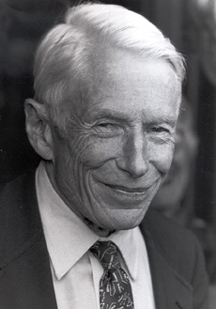Geotimes

In Memoriam
Konrad B. Krauskopf
Gary Ernst
 On May 4, 2003,
Konrad B. Krauskopf passed away peacefully in his on-campus home. He was 92
years old. Known to many as “Konnie,” he had been a member of the
Stanford faculty since 1939, first as professor, then after 1976 as professor
emeritus. His was a lifetime of extraordinary achievement in both geology and
geochemistry.
On May 4, 2003,
Konrad B. Krauskopf passed away peacefully in his on-campus home. He was 92
years old. Known to many as “Konnie,” he had been a member of the
Stanford faculty since 1939, first as professor, then after 1976 as professor
emeritus. His was a lifetime of extraordinary achievement in both geology and
geochemistry.
Krauskopf received a Ph.D. in chemistry at the University of California, Berkeley,
in 1934, and a second doctorate in geology at Stanford University in 1939. This
educational background, both remarkably broad and deep, along with concurrent
service as university instructor in the physical sciences, equipped Krauskopf
for a scholarly career characterized by breathtaking interdisciplinary contributions.
He made numerous original contributions in all aspects of academic performance
that we deem critically important-research, instruction and public as well as
professional service.
Photo of Konrad B. Krauskopf
courtesy of Stanford University.
Krauskopf published a diverse set of internationally recognized
and acclaimed investigations, broadly arching across the fields of hard-rock
geology, petrology, aqueous geochemistry and mineral deposits. He provided seminal,
pioneering investigations of the trace-element constitution of seawater, the
geochemistry of ore-forming supercritical aqueous fluids and the solubility
of silica. Detailed petrologic studies include illuminating the origin and petrogenetic
evolution of granitoids and basement terranes in the Pacific Northwest, the
volcanic eruptions of Parícutin in the Transmexican volcanic belt, and
the regional petrologic development of coastal Norway. In parallel, he generated
both mineral deposit maps and general geologic maps for the California Division
of Mines and Geology (now the California Geological Survey) and for the U. S.
Geological Survey, chiefly in the Sierra Nevada and the White-Inyo ranges of
eastern California. Having provided geoscientists with pioneering, discipline-defining
texts in geochemistry and physical geology over a span of five decades, Krauskopf
quite literally wrote the book on application of the principles of physics and
chemistry to Earth. These forward-looking works focused on and illuminated the
fundamental chemical and physical foundations of the earth sciences. Special
emphases have included elucidation of aqueous solution-metal complex equilibria
as well as thermodynamic applications to solid-melt-fluid partitioning, published
at a time when most earth scientists were mapping quadrangles. Krauskopf did
that too, having published seven quadrangle maps.
Acclaimed books include: The Third Planet, Introduction to Geochemistry,
Fundamentals of Physical Science, The Physical Universe, Radioactive
Waste Disposal and Geology and Introduction to Physics and Chemistry.
Most of these texts have run through several (up to 10!) editions.
He was a civilian member of the military geology division of the U. S. Army
during World War II. In 1947, he was appointed chief of the G-2 geographic section
in Tokyo, and received a citation for meritorious civilian service. Krauskopf
served for more than a decade as a member, then chair, of the U. S. National
Research Council Board on Radioactive Waste Management, and was responsible
for an outstanding National Academy report on the subject that defined and quantified
problems.
Krauskopf received many honors during his long career. He was the recipient
of Fulbright, Guggenheim and National Science Foundation fellowships for research
study abroad. He was elected to membership in the National Academy of Sciences
and in the American Philosophical Society. He served as president of the American
Geological Institute in 1964, received its Ian Campbell Medal in 1984 and its
Legendary Geoscientist Award in 2000. He was elected president of the Geological
Society of America in 1967, and was awarded its Arthur L. Day Medal in 1961.
Krauskopf served as president of the Geochemical Society in 1970 and received
its V. M. Goldschmidt Medal in 1982. In 1994, he was honored with the Mineralogical
Society of America Distinguished Public Service Award.
A symposium held at Stanford in December, 1999 in honor of Krauskopf resulted
in the two-volume Krauskopf Volume, Frontiers in Geochemistry: I Global Inorganic
Geochemistry; II Organic, Solution, and Ore Deposit Geochemistry, published
jointly by Bellwether Publishing and the Geological Society of America. It is
difficult to think of any other geochemist who so faithfully served the earth
science profession in such far-ranging ways, being enormously impactful in all
of them: as geologist, geochemist, and science/technology advisor to the nation.
Ernst is the Benjamin M. Page
Professor of Geological and Environmental Sciences at Stanford University. He
studies the petrotectonic evolution of Circumpacific contractional mountain belts.
The American Geological Institute gave its first
Legendary Geoscientist Award in 1999. The award recognizes a geoscientist who
has produced scientific achievements and service to the earth sciences that
have lasting, historic value.
Back to top
 On May 4, 2003,
Konrad B. Krauskopf passed away peacefully in his on-campus home. He was 92
years old. Known to many as “Konnie,” he had been a member of the
Stanford faculty since 1939, first as professor, then after 1976 as professor
emeritus. His was a lifetime of extraordinary achievement in both geology and
geochemistry.
On May 4, 2003,
Konrad B. Krauskopf passed away peacefully in his on-campus home. He was 92
years old. Known to many as “Konnie,” he had been a member of the
Stanford faculty since 1939, first as professor, then after 1976 as professor
emeritus. His was a lifetime of extraordinary achievement in both geology and
geochemistry. 
